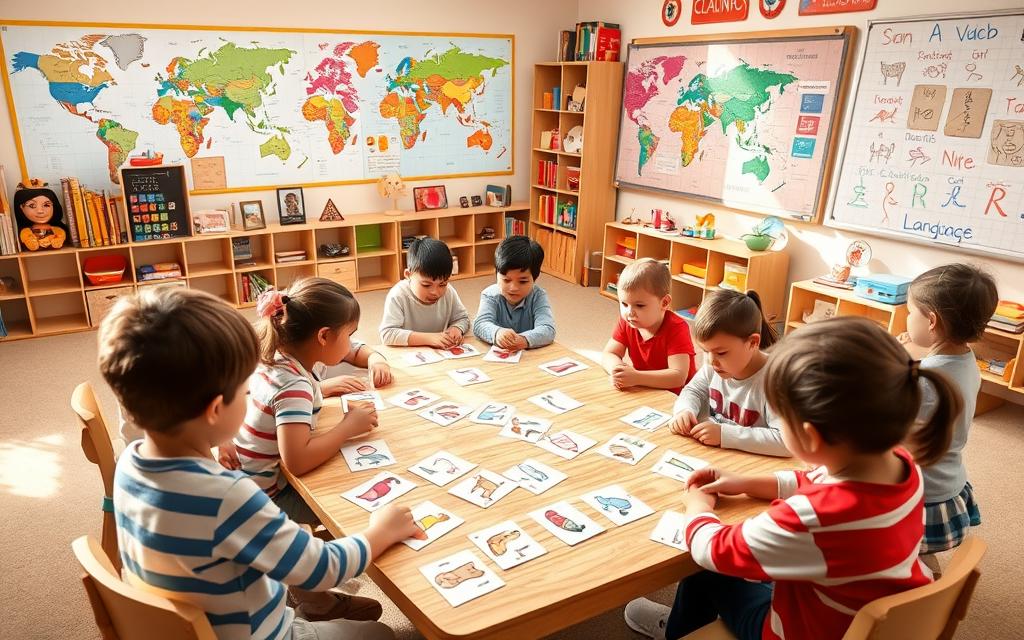Did you know that about 80% of language learning happens through fun and interactive ways? This shows how vital engaging foreign language activities for early childhood are for young kids. They help with learning languages, thinking skills, and getting along with others.
These activities are key in the preschool years. By age five, 90% of a child’s brain grows. Early education is crucial for introducing languages to kids.
It’s important to use fun and interactive ways to teach languages. Group games, making numbers with the body, and talking with friends help a lot. Activities like picture stories and body numbers are great for teaching languages to kids.
Engaging in foreign language activities for early childhood can really help kids. It boosts their language skills, social abilities, and thinking. By adding these activities to early education, kids get a strong start in learning languages.
Understand the Benefits of Early Foreign Language Learning
Learning a foreign language early on is great for kids. It boosts their thinking skills, social abilities, and understanding of different cultures. Kids can start learning languages as young as preschool.
Studies show that young language learners do better in reading, memory, and solving problems. For instance, a study found that students with 4 or more years of foreign language study score 140 points higher on the SAT. This is compared to students with less than half a year of experience.
Cognitive Development Advantages
Learning a new language helps kids understand and use their first language better. It also strengthens concepts learned in both languages. Bilingual kids have more “grey matter” in their brains. This is important for processing information, memory, speech, and sensory perception.
Social and Cultural Benefits
Learning multiple languages helps kids develop social skills, cultural awareness, and empathy. They also show better problem-solving skills and memory compared to kids who only speak one language. Learning a language early on can also lead to better job opportunities and higher salaries later on.
Long-term Educational Impact
Colleges value students who know more than one language, especially as admissions get tougher. Knowing multiple languages opens up more job opportunities and can lead to higher salaries. By teaching languages early, parents and teachers give kids a strong start for their future.
Language Acquisition Potential
Children’s brains are highly receptive to language learning during early developmental stages.
Create an Effective Foreign Language Environment
Creating a supportive and immersive language learning space is key for young children to grow their bilingual skills. Interactive language activities and engaging language activities help make this space interactive and engaging. For example, using flashcards and traditional music can teach vocabulary and introduce culture.
Studies show that early language learners have better pronunciation and understanding. Bilingual activities for young children can be woven into daily life. This makes learning a language a natural part of their world. Some effective methods include:
- Using songs and music to increase vocabulary retention by 30%
- Implementing interactive language apps to improve language learning outcomes by 40%
- Pairing children with peers who speak the target language to reinforce language development

By using these strategies, educators and parents can build a great language learning environment. Engaging language activities and interactive language activities can be customized for each child. This makes learning a language fun and enjoyable.
Interactive Songs and Music Activities for Language Learning
Interactive songs and music are key for young children to learn languages. They help with up to 90% of language learning through sound and touch. Singing and moving around can help kids remember words and sentences in a new language.
Studies show kids learn new words 20% faster when they hear music and rhythm. Activities like singing and playing music games boost memory and speaking skills. For instance, “Bingo” helps with letter recognition, and “Hokey Pokey” teaches body parts and movement.
Songs carry cultural meanings that help kids connect emotionally and learn better. Using hand gestures while singing helps kids remember song meanings. Interactive songs and music make learning a new language fun and engaging for kids.
Foreign Language Activities for Early Childhood Through Play
Play is key in early childhood education. It’s a great way to introduce foreign languages to young kids. These activities make learning a language fun and engaging.
Play-based learning is effective for teaching many subjects, including languages. It’s recognized as a powerful method in early childhood education.
Examples of these activities include imaginative play, language games, and puppet shows. They help kids learn languages naturally and interactively. For example, teachers can use puppets to teach new words and grammar.
Games like Charades, Bingo, and Pictionary can help build vocabulary in a foreign language. These games can be played in class or at home. They make learning a language easy and fun for kids.
By adding these activities to early childhood education, kids get a strong language foundation. They also gain cognitive and social benefits from being bilingual.
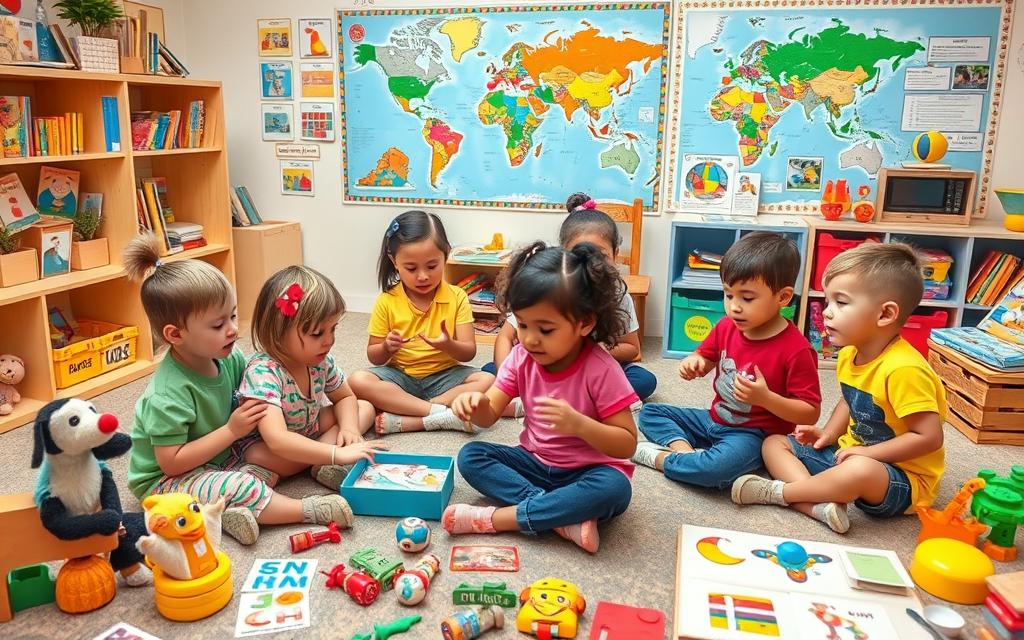
Play is a natural and effective way for children to learn, as it engages their senses, promotes creativity, and encourages social interaction. Here are some fun and engaging activities that you can incorporate into your child’s daily routine to help them start learning a new language:
1. Music and Movement: Use songs and dances in different languages to introduce new vocabulary and phrases. Encourage your child to sing along, mimic the movements, and dance to the beat. This will not only help them remember the words but also make learning a new language a fun and memorable experience.
2. Storytelling and Puppet Shows: Create simple stories or skits in a foreign language and act them out with puppets or stuffed animals. Use gestures, facial expressions, and props to help your child understand the storyline. This activity will enhance their listening skills, boost their imagination, and improve their language comprehension.
3. Flashcards and Memory Games: Make flashcards with pictures of common objects or animals, labeled in both English and the target language. Play memory games with the flashcards, asking your child to match the correct pairs. This activity will help them recognize and associate words in different languages, building their vocabulary and language skills.
4. Cooking and Baking: Get your child involved in cooking or baking recipes from a foreign country. Read the recipe out loud together in the target language, and talk about the ingredients and cooking instructions. This hands-on activity will not only teach your child new words but also introduce them to different cuisines and cultures.
5. Language Learning Apps and Online Resources: There are several interactive and educational apps and websites available that are designed to teach children new languages through games, videos, and quizzes. Allow your child to explore these resources on their own or with your guidance to practice and reinforce their language skills.
6. Labeling objects: Use labels or cards with the foreign language word for common objects in the child’s environment, such as “table,” “chair,” or “toy.” Encourage the child to match the object with the corresponding word, helping them to make connections between the object and the word in the foreign language.
7. Role-playing: Encourage children to engage in pretend play using the foreign language. For example, they can play “restaurant” and practice ordering food in the foreign language, or they can pretend to be on a trip to a foreign country and use the language to ask for directions or make purchases.
By incorporating these foreign language activities into your child’s daily routine, you are providing them with valuable opportunities to learn and grow while having fun. Remember to be patient and encouraging, as learning a new language takes time and practice. With consistency and support, your child will soon be on their way to becoming a confident and proficient bilingual speaker.
Storytelling and Picture Book Activities
Engaging in multicultural activities for children is key for their early childhood development. Storytelling and picture book activities are great ways to do this. They help kids learn new words and grammar. Plus, they introduce them to various cultures and lifestyles.
Using bilingual activities for young children is especially good. It lets them learn and understand more than one language early on. Bilingual picture books are a great tool. They help kids grow their language skills and learn about different cultures.
- Reading bilingual picture books together
- Engaging in storytelling activities that incorporate different cultures and languages
- Using props and visual aids to help children understand and engage with the story
These activities boost kids’ language skills and introduce them to new cultures. By making bilingual activities for young children a part of their daily life, parents and caregivers foster a love for learning. They also help kids appreciate different cultures.
Digital Tools and Technology for Language Learning
Language learning has become more fun and interactive with digital tools. Online games and quizzes help improve language skills and learn about different cultures. Virtual cultural exchanges let learners practice their language in real-life situations.
Language learning apps are great for teaching vocabulary and grammar. Duolingo offers personalized lessons that focus on practical use. It helps with reading, writing, listening, and speaking. Other tools like BBC Bitesize and PBS Kids provide audiovisual lessons and interactive materials for learning foreign languages.
Some popular language learning apps include:
- Digital Dialects, which offers interactive materials for learning 80 foreign languages
- Gus on the Go, which provides apps for 30 languages, priced at $3.99 each
- Mondly Kids, which offers gamified lessons in 33 different languages
These digital tools make learning languages fun and engaging. By using interactive, engaging, and hands-on activities, learners can develop a lifelong love for language.
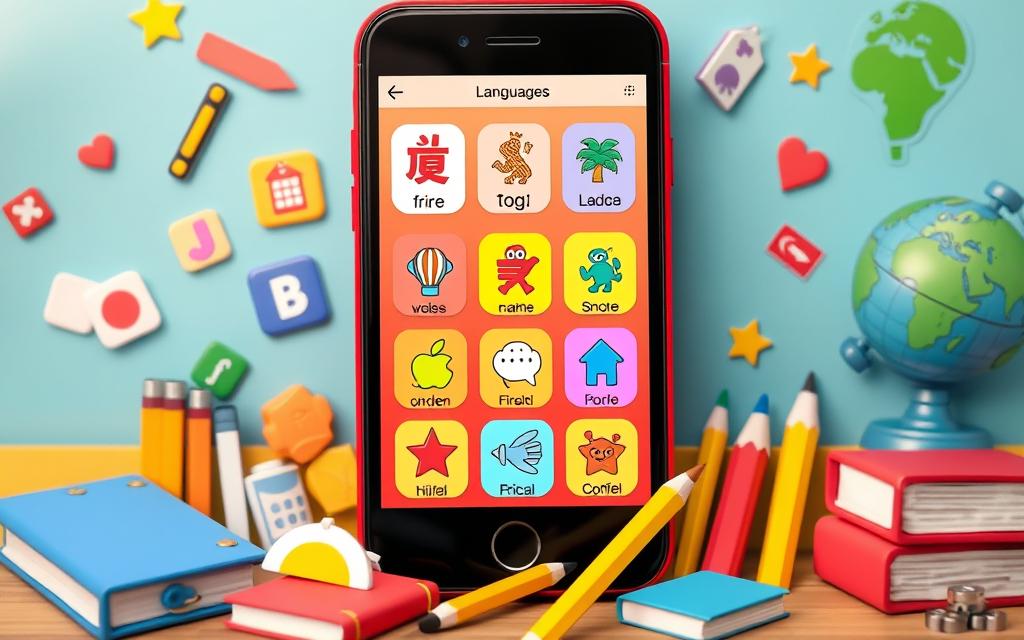
Incorporate Cultural Activities and Celebrations
Cultural activities and celebrations are key in foreign language immersion for kids. They offer a chance for children to explore different cultures. This helps them understand the world better. By adding multicultural activities for children to learning, teachers make the classroom more diverse and inclusive.
Examples of cultural activities include traditional games, crafts, and art projects. These activities help kids learn about different cultures. They also improve language skills and thinking abilities. For example, a teacher might have a dress-up day or a cooking session to learn about various traditions.
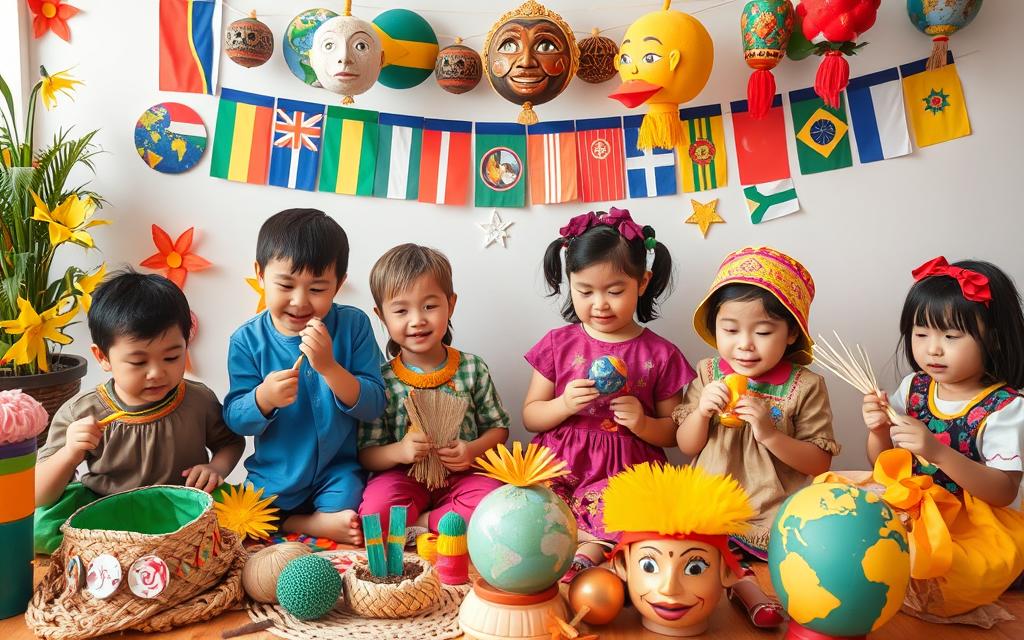
Teachers can also use multicultural activities for children to teach languages and culture. They might have kids research and share about different celebrations. This way, kids learn new languages and about different cultures.
Adding cultural activities to learning makes the classroom more fun and diverse. It helps kids grow in many ways. They become more aware and sensitive to different cultures.
Assessment and Progress Tracking Methods
Learning a new language is a big challenge for kids. It needs ongoing checks and tracking of progress. In Massachusetts, schools must watch how kids grow in five key areas: thinking, moving, speaking, feeling, and learning.
Tests help find out if kids need extra help. Tools like the Work Sampling System show how kids improve over time. Teachers and parents work together to see how kids are doing.
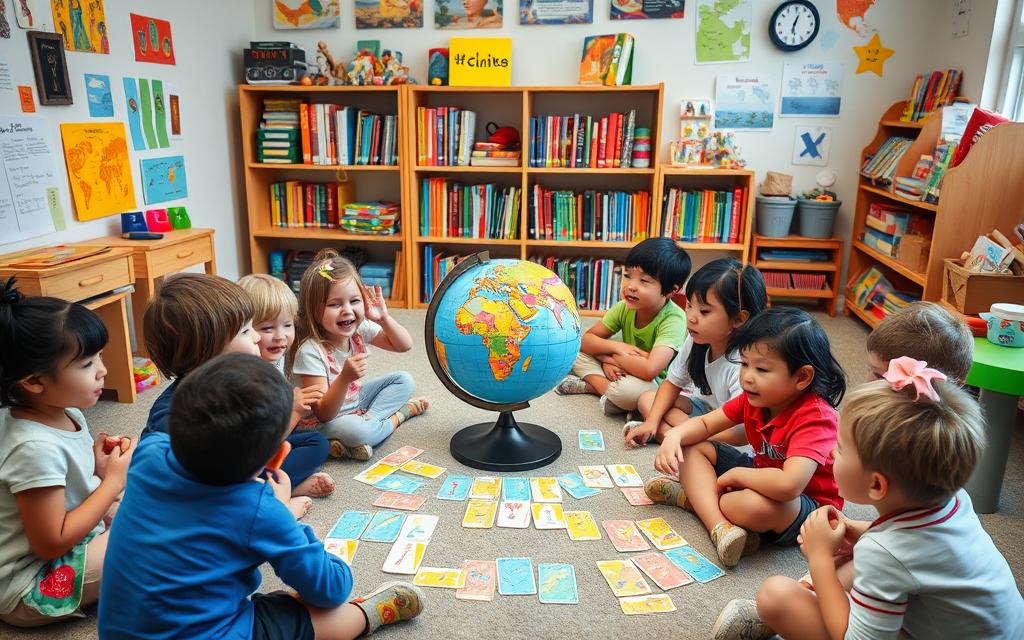
Assessments go through six steps: teach, watch, record, analyze, summarize, and start again. This ensures kids hit their growth targets and get lessons tailored to them. Teachers use many ways to check how kids are doing, like watching, writing down, and tests.
Some important things to think about when checking how kids learn languages include:
- Using different ways to see how well kids can do things
- Teaching each kid based on what they can do
- Working with parents to help kids learn
- Using online tools to make tracking easier
By using these methods, teachers can help kids get better at languages. Fun activities, like learning two languages, make learning exciting and help kids understand different cultures.
Build a Supportive Language Learning Community
Creating a supportive language learning community is key for kids to grow their language skills. This can happen through engaging language activities that get everyone involved. Hands-on language activities let kids learn through play, making it fun and effective.
Introducing kids to a new language through foreign language immersion for kids is a great idea. Activities like singing songs, playing games, and reading books in the target language work well. When learning a language is fun and interactive, kids stay interested and motivated.
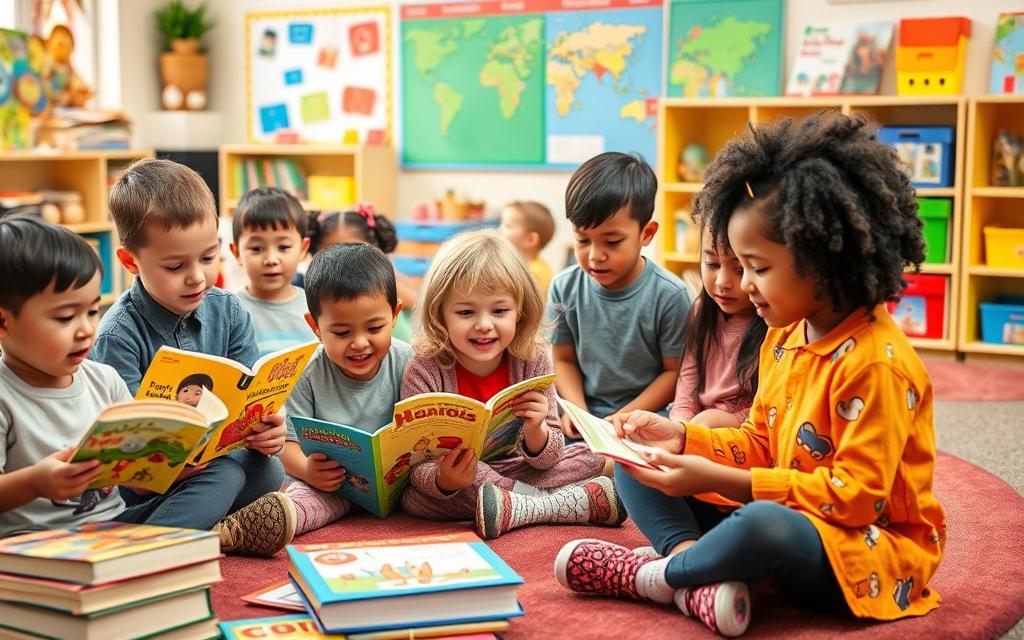
- Encourage parents to get involved with regular updates and progress reports.
- Give kids chances to learn from each other and interact.
- Make sure the environment is safe and welcoming, where everyone feels included.
Together, we can build a supportive community. This community will help kids grow their language skills and reach their goals.
Foster a Lifelong Love for Language Learning
Learning a foreign language is vital for today’s early childhood education. About 20% of kids in the Global North are learning multiple languages. Almost half of the world’s children grow up speaking more than one language.
This not only improves their cognitive development and social skills. It also gives them an edge in the global job market.
Interactive language learning activities are essential for sparking a love for languages early on. Activities like movement songs, cultural crafts, and digital apps are great. They help kids learn new words, speak fluently, and understand different cultures.
Creating a supportive learning space is key. It helps kids feel confident and ready to succeed in our connected world. By getting parents and the community involved, educators can help children become multilingual and thrive.
Strategies for Teaching Foreign Languages to Young Learners
1. Make Learning Playful
Incorporate games, songs, and activities to keep learning enjoyable and age-appropriate.
2. Use Repetition and Routine
Repetition helps reinforce vocabulary and sentence structures, making them easier to remember.
3. Integrate Visuals and Props
Pictures, flashcards, and real-world objects help children associate words with their meanings.
4. Incorporate Movement
Combine language learning with physical activities like gestures, dancing, and role-playing.
5. Celebrate Small Achievements
Reward progress with praise or small incentives to build confidence and motivation.
20 Classroom Activities for Teachers
1. Color Matching Games
Teach colors by matching objects or flashcards to their names in the target language.
2. Song Time
Sing simple songs in the foreign language, incorporating hand motions.
3. Role-Playing
Act out everyday scenarios, like going to the store or greeting a friend.
4. Language Circle Time
Dedicate time each day to learning new vocabulary and practicing sentences.
5. Storytelling
Read picture books in the foreign language and discuss the story.
6. Alphabet Games
Use puzzles or games to teach the alphabet in the target language.
7. Flashcard Relay
Place flashcards around the room and have children run to the correct card when called out.
8. Cooking Activities
Introduce food vocabulary by making simple recipes together.
9. Guess the Word
Describe an object in the target language and have children guess what it is.
10. Action Songs
Combine songs with movements to teach verbs and actions.
11. Cultural Days
Dedicate a day to learning about a culture that speaks the target language.
12. Matching Games
Match words with corresponding images.
13. Daily Words
Introduce a “word of the day” and use it throughout the day.
14. Interactive Whiteboards
Use digital tools to teach vocabulary through games and videos.
15. Counting Games
Practice numbers with counting exercises and objects.
16. Mystery Bag
Fill a bag with objects and let children describe or guess them in the target language.
17. Weather Reports
Teach weather-related vocabulary by discussing daily weather conditions.
18. Animal Sounds
Learn animal names and sounds in the target language.
19. Holiday Themes
Use holidays as an opportunity to introduce related vocabulary and traditions.
20. Classroom Labels
Label items in the classroom with their names in the foreign language.
20 Homeschool Activities for Parents
1. Daily Vocabulary Practice
Learn a few new words every day and use them in sentences.
2. Language Flashcards
Create flashcards for common objects and review them daily.
3. Nursery Rhymes
Sing nursery rhymes in the foreign language.
4. Language Apps
Use child-friendly apps to make learning interactive and fun.
5. Bilingual Storybooks
Read stories with side-by-side translations.
6. Shopping List Practice
Write shopping lists in the foreign language and discuss items during shopping.
7. Cooking Together
Name ingredients and actions while preparing meals.
8. Nature Walk Vocabulary
Learn words for plants, animals, and weather during outdoor walks.
9. Arts and Crafts
Create themed crafts while discussing colors and materials in the target language.
10. Puppet Shows
Perform short skits using puppets to practice dialogues.
11. Daily Greetings
Practice greetings and polite phrases every morning.
12. DIY Labeling
Label items around the house in the foreign language.
13. Calendar Activities
Learn days, months, and seasons in the target language.
14. Interactive Videos
Watch educational videos in the foreign language.
15. Family Word Jar
Introduce a new word daily and have everyone use it in a sentence.
16. Simple Board Games
Play board games with instructions or themes in the target language.
17. Rhyming Games
Practice rhymes and word families in the foreign language.
18. Cultural Cooking Nights
Prepare traditional meals from countries that speak the language.
19. DIY Vocabulary Wall
Create a wall chart to track new vocabulary.
20. Memory Games
Use matching games with foreign language vocabulary.
Incorporating foreign language activities for early childhood is both rewarding and effective when tailored to young learners’ needs. By fostering a love for language through engaging activities, parents and teachers can set children on a path toward lifelong linguistic and cultural proficiency. With a mix of classroom and homeschool strategies, the journey to language learning becomes an enjoyable adventure for all involved.
Key Takeaways
- Engaging foreign language activities can promote language learning, cognitive development, and social skills in young children.
- Approximately 80% of language acquisition occurs through interactive and playful methods.
- Early childhood education plays a significant role in introducing language learning for kids.
- Foreign language activities, such as picture storytelling and body numbers, can be effective in teaching foreign languages to kids.
- Engaging foreign language activities can have a significant impact on a child’s language development, social skills, and cognitive abilities.
- Language learning for kids is an essential aspect of early childhood education.
Source Links
- How to Teach Kids a Foreign Language with Activities – Novak Djokovic Foundation – https://novakdjokovicfoundation.org/foreign-language-activities/
- 20 Best Language and Literacy Activities for Preschoolers – https://blog.acceleratelearning.com/20-best-language-and-literacy-activities-for-preschoolers
- Unlock Engaging Language and Literacy Activities for Preschoolers – https://www.vancopayments.com/child-care/blog/literacy-activities-for-preschoolers
- Top 10 Benefits of Learning a Second Language at an Early Age – Spanish Immersion Workshop – https://spanishiw.com/top-10-benefits-learning-second-language-early-age/
- Raising multilingual children: the benefits of early language learning – https://school-education.ec.europa.eu/en/discover/news/raising-multilingual-children-benefits-early-language-learning
- Foreign language teaching methods to help children speak fluently | Allison Academy – https://www.allisonacademy.com/parents/parenting/foreign-language-teaching-methods/
- 10 Tips for Teaching Young Dual Language Learners Effectively – https://brookespublishing.com/newsletters/early-childhood-newsletter/10-tips-for-teaching-young-dual-language-learners-effectively/?srsltid=AfmBOopeWNPHwaebvjsO70B08waBRFo_AATvOShBJESWy6u_tQlx_CoN
- Best Songs for Language Development – Plus a Free Printable – https://speakplaylove.com/12-childrens-songs-to-help-with-language-development/
- Singing in a second language: activity for children 0-6 years – https://raisingchildren.net.au/guides/activity-guides/sounds-songs-music/singing-in-a-second-language-activity-for-children-0-6-years
- Simple Songs to Sing to Help Teach a Second Language to your Kids | TruFluency Kids – https://trufluencykids.com/bilingual-music-singing-with-your-kids-in-a-second-language/
- Teaching Foreign Language During the Early Years – Homeschool Compass – https://homeschoolcompass.com/teaching-foreign-language-during-the-early-years/
- 16 Language Learning Games & Activities: Fun & Effective – https://preply.com/en/blog/at-home-language-learning-games/
- Easy Ways to Teach Your Child a Foreign Language From 0-6 Years – https://www.theculturedkid.com/blog/nurture-language-development
- Reading and storytelling with babies and children – https://raisingchildren.net.au/babies/play-learning/literacy-reading-stories/reading-storytelling
- 11 Best Storytelling Activities for Kids in 2025 – https://www.splashlearn.com/blog/best-storytelling-activities-for-kids/
- Reading with preschoolers – https://raisingchildren.net.au/preschoolers/play-learning/literacy-reading-stories/reading-with-preschoolers
- PDF – https://files.eric.ed.gov/fulltext/EJ1386834.pdf
- 10 Apps and Websites to Help Kids Learn a Second Language – https://amshq.org/Blog/2024-07-22-10-Apps-and-Websites-to-Help-Kids-Learn-a-Second-Language
- Embracing Cultural Diversity in Preschool: 10 Simple Activities to Teach Children About Different Cultures — Daycare Studio – https://www.daycarestudio.net/home/embracing-cultural-diversity-in-preschool?srsltid=AfmBOooVjc1JPU3qOU8mULconiKMZz6coZfh7Igc1LaQ5_8QuateUtTQ
- 11 Creative Ways To Celebrate Cultural Diversity In The Classroom – https://www.continentalpress.com/blog/cultural-diversity-in-the-classroom/?srsltid=AfmBOoowj1XTk-XeCBpyEczOWMIIpuu7EK7yN0A5LF9SMmdXqwxfzLWW
- 10 classroom activities to promote cultural awareness – https://screenpal.com/blog/cultural-awareness
- Early Childhood Assessment: Resources for Early Learning – http://resourcesforearlylearning.org/fm/early-childhood-assessment/
- DAP: Observing, Documenting, and Assessing Children’s Development and Learning – https://www.naeyc.org/resources/position-statements/dap/assessing-development
- Supporting Language Development in the Early Childhood Classroom – https://www.communityplaythings.com/resources/articles/supporting-language-development
- 10 Tips for Teaching Young Dual Language Learners Effectively – https://brookespublishing.com/newsletters/early-childhood-newsletter/10-tips-for-teaching-young-dual-language-learners-effectively/?srsltid=AfmBOop9PmhuZcz-GnktuBEFsyIjY0lQlTTWBYCRz8r-yEnT3iVHM5jf
- Supporting Dual Language Learners in Early Childhood Education – Early Care & Learning Council 1 – https://earlycareandlearning.org/supporting-dual-language-learners-in-early-childhood-education/
- Building a Bilingual Brain: The Advantages of Early Language Learning – LITTLE PLANET PRESCHOOL – https://littleplanetps.com/building-a-bilingual-brain-the-advantages-of-early-language-learning/
- The Power of Early Literacy: Building Strong Foundations for Lifelong Learning – https://www.voyagersopris.com/vsl/blog/the-power-of-early-literacy
- Integrating Language Learning into Early Education: Best Practices for Educators and Parents – https://www.safesearchkids.com/integrating-language-learning-into-early-education/

